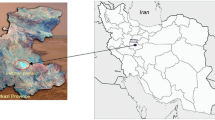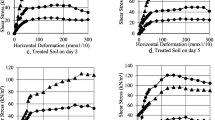Abstract
Microbial-induced calcite precipitation (MICP) is one of the environmentally friendly techniques that has recently become popular amongst geotechnical engineers. Two bacterial species of Bacillus family, i.e., B. pasteurii and B. megaterium have been used to improve the loess soil properties. A set of unconfined compressive, permeability, ultrasonic, and collapse potential tests have been applied to assess the characteristics of natural soil compared to those of MICP-treated ones. The effects of curing time (1, 3, and 7 days), bacterial optical density (OD = 0.5, 1, and 1.5), and soil density (13, 14, and 15 \( \frac{kN}{m^3} \)) have been investigated. Results indicate that biological enhancement has improved the engineering properties of the loess soil. MICP-treated soil using B. megaterium provides higher strength improvement ratios (1.15–4.4 times) rather than B. pasteurii-treated samples (1.05–3.4 times). Correspondingly, specimens containing B. megaterium have greater permeability reduction ratios (3.9–93.7%) compared with those of B. pasteurii ones (2–95%). Moreover, scanning electron microscope (SEM) analysis has been employed to confirm the findings. It is worth noting that various bacteria concentrations, curing periods, and soil densities can affect the stress-strain curve considerably. The results indicated that MICP reduced the collapse potential between 24 and 54.8% and increased the longitudinal wave velocity between 1.1 and 2.4 times more than the untreated soil.













Similar content being viewed by others
References
ASTM D2166–06 (2006) Standard test method for unconfined compressive strength of cohesive soil. ASTM International, West Conshohocken, PA. https://doi.org/10.1520/D2166-06
ASTM D2845–08 (2008) Standard test method for laboratory determination of pulse velocities and ultrasonic elastic constants of rock. ASTM International, West Conshohocken, PA. https://doi.org/10.1520/D2845-08
ASTM D5084–03 (2003) Standard test methods for measurement of hydraulic conductivity of saturated porous materials using a flexible wall permeameter. ASTM International, West Conshohocken, PA. https://doi.org/10.1520/D5084-03
ASTM D5333–92 (1996) Standard test method for measurement of collapse potential of soils. ASTM International, West Conshohocken, PA. https://doi.org/10.1520/D5333-92R96
Cabalar AF, Karabash Z, Erkmen O (2018) Stiffness of a biocemented sand at small strains. Eur J Environ Civ Eng 22:1238–1256. https://doi.org/10.1080/19648189.2016.1248791
Canakci H, Sidik W, Kilic IH (2015) Effect of bacterial calcium carbonate precipitation on compressibility and shear strength of organic. Soils Found 55:1211–1221. https://doi.org/10.1016/j.sandf.2015.09.020
Cheng L, Shahin MA (2019) Microbially induced calcite precipitation (MICP) for soil stabilization. In: Ecological Wisdom Inspired Restoration Engineering.EcoWISE. Springer Singapore, Singapore, pp 47–68. https://doi.org/10.1007/978-981-13-0149-0_3
Cheng L, Cord-Ruwisch R, Shahin MA (2013) Cementation of sand soil by microbially induced calcite precipitation at various degrees of saturation. Can Geotech J 50:81–90. https://doi.org/10.1139/cgj-2012-0023
Cheng L, Shahin MA, Mujah D (2016) Influence of key environmental conditions on microbially induced cementation for soil stabilization. J Geotech Geoenviron 143:04016083. https://doi.org/10.1061/(ASCE)GT.1943-5606.0001586
Cheshomi A, Mansouri S, Amoozegar MA (2018) Improving the shear strength of quartz sand using the microbial method. Geomicrobiol J 35:749–756. https://doi.org/10.1080/01490451.2018.1462868
Dehghan H, Tabarsa AR, Latifi N, Bagheri Y (2019) Use of xanthan and guar gums in soil strengthening. Clean Techn Environ Policy 21:155–165. https://doi.org/10.1007/s10098-018-1625-0
Dejong JT, Kavazanjian E (2019) Bio-mediated and bio-inspired geotechnics. In: Geotechnical Fundamentals for Addressing New World Challenges. Springer, Berlin, pp 193–207. https://doi.org/10.1007/978-3-030-06249-1_7
Dejong J, Martinez B, Mortensen B, Nelson D, Waller J, Weil M, Ginn T, Weathers T, Barkouki T (2009) Fujita Y. Upscaling of bio-mediated soil improvement, Idaho National Laboratory (INL) https://www.osti.gov/servlets/purl/968679
Fauriel S, Laloui L (2013) Biogeochemical processes and geotechnical applications: progress, opportunities and challenges. Geotechnique. 63:287–301. https://doi.org/10.1680/geot.SIP13.P.017
Gomez MG, Graddy CM, Dejong JT, Nelson DC, Tsesarsky M (2017) Stimulation of native microorganisms for biocementation in samples recovered from field-scale treatment depths. J Geotech Geoenviron 144:04017098. https://doi.org/10.1061/(ASCE)GT.1943-5606.0001804
Gong X, Niu J, Liang S, Feng D, Luo Q (2019) Environmental effect of grouting batches on microbial-induced calcite precipitation. Ekoloji Dergisi 107:929–936
Grabiec AM, Starzyk J, Stefaniak K, Wierzbicki J, Zawal D (2017) On possibility of improvement of compacted silty soil using biodeposition method. Constr Build Mater 138:134–140. https://doi.org/10.1016/j.conbuildmat.2017.01.071
Haeri SM, Zamani A, Garakani AA (2012) Collapse potential and permeability of undisturbed and remolded loessial soil samples. In: Unsaturated soils: research and applications. Springer, Berlin, Heidelberg, pp 301–308. https://doi.org/10.1007/978-3-642-31116-1_41
Haeri SM, Akbari Garakani A, Roohparvar HR, Desai CS, Seyed Ghafouri SMH, Salemi Kouchesfahani K (2019) Testing and constitutive modeling of lime-stabilized collapsible loess. I: Experimental investigations. Int J Geomech 19(4):04019006. https://doi.org/10.1061/%28ASCE%29GM.1943-5622.0001386
Li M, Cheng X, Guo H (2013) Heavy metal removal by biomineralization of urease producing bacteria isolated from soil. Int Biodeterior Biodegradation 76:81–85. https://doi.org/10.1016/j.ibiod.2012.06.016
Liu L, Hanlong L, Yang X, Chu J, Xiao P, Wang Y (2018) Biocementataion of calcareous sand using soluble calcium derived from calcareous sand. Bull Eng Geol Environ. https://doi.org/10.1007/S10064-017-1106-4
Montoya B, Dejong J, Boulanger RW, Wilson DW, Gerhard R, Ganchenko A, Chou JC (2012) Liquefaction mitigation using microbial induced calcite precipitation. GeoCongress 2012: State of the Art and Practice in Geotechnical Engineering. 1918–1927
Moradi R, Marto A, Rashid ASA, Moradi MM, Ganiyu AA, Horpibulsuk S (2018) Bearing capacity of soft soil model treated with end-bearing bottom ash columns. Environ Earth Sci 77(3):100. https://doi.org/10.1007/s12665-018-7287-8
Morales L, Romero E, Jommi C, Garzón E, Giménez A (2015) Feasibility of a soft biological improvement of natural soils used in compacted linear earth construction. Acta Geotech 10:157–171. https://doi.org/10.1007/s11440-014-0344-x
Moravej S, Habibagahi G, Nikooee E, Niazi A (2018) Stabilization of dispersive soils by means of biological calcite precipitation. Geoderma 315:130–137. https://doi.org/10.1016/j.geoderma.2017.11.037
Mukherjee S, Sahu RB, Mukherjee J, Sadhu S (2019) Application of microbial-induced carbonate precipitation for soil improvement via ureolysis. In: Thyagaraj T (ed) Ground improvement techniques and Geosynthetics, Singapore. Springer, Singapore, pp 85–94. https://doi.org/10.1007/978-981-13-0559-7_10
Okwadha GD, Li J (2010) Optimum conditions for microbial carbonate precipitation. Chemosphere. 81:1143–1148. https://doi.org/10.1016/j.chemosphere.2010.09.066
Phummiphan I, Horpibulsuk S, Rachan R, Arulrajah A, Shen SL, Chindaprasirt P (2018) High calcium fly ash geopolymer stabilized lateritic soil and granulated blast furnace slag blends as a pavement base material. J Hazard Mater 341:257–267. https://doi.org/10.1016/j.jhazmat.2017.07.067
Proto CJ, Dejong J, Nelson D (2016) Biomediated permeability reduction of saturated sands. J Geotech Geoenviron 142:04016073. https://doi.org/10.1061/(ASCE)GT.1943-5606.0001558
Ramachandran SK, Ramakrishnan V, Bang SS (2001) Remediation of concrete using micro-organisms. ACI Materials Journal-American Concrete Institute 98:3–9 http://worldcat.org/oclc/13846872
Sharma A, Ramkrishnan R (2016) Study on effect of microbial induced calcite precipitates on strength of fine grained soils. Perspect Sci 8:198–202. https://doi.org/10.1016/j.pisc.2016.03.017
Soon NW, Lee LM, Hii SL (2012) An overview of the factors affecting microbial-induced calcite precipitation and its potential application in soil improvement. World Acad Sci Eng Technol 62:723–729
Soon NW, Lee LM, Khun TC, Ling HS (2013) Improvements in engineering properties of soils through microbial-induced calcite precipitation. KSCE J Civ Eng 17:718–728. https://doi.org/10.1007/s12205-013-0149-8
Soon NW, Lee LM, Khun TC, Ling HS (2014) Factors affecting improvement in engineering properties of residual soil through microbial-induced calcite precipitation. J Geotech Geoenviron 140(5). https://doi.org/10.1061/(ASCE)GT.1943-5606.0001089
Stocks-Fischer S, Galinat JK, Bang SS (1999) Microbiological precipitation of CaCo3. Soil Biol Biochem 31:1563–1571. https://doi.org/10.1016/S0038-0717(99)00082-6
Sun X, Miao L, Tong T, Wang C (2019) Study of the effect of temperature on microbially induced carbonate precipitation. Acta Geotech 14:627–638. https://doi.org/10.1007/s11440-018-0758-y
Tabarsa A, Latifi N, Meehan CL, Manahiloh KN (2018) Laboratory investigation and field evaluation of loess improvement using nanoclay–a sustainable material for construction. Constr Build Mater 158:454–463. https://doi.org/10.1016/j.conbuildmat.2017.09.096
Valizade N (2018) Effect of Vetiver plant reinforcement on the engineering behavior of loess soil. Geotechnical Engineering, Golestan University, Iran, Master of Science
Whiffin VS, Van Paassen LA, Harkes MP (2007) Microbial carbonate precipitation as a soil improvement technique. Geomicrobiol J 24:417–423. https://doi.org/10.1080/01490450701436505
Wong LS (2015) Microbial cementation of ureolytic bacteria from the genus Bacillus: a review of the bacterial application on cement-based materials for cleaner production. J Clean Prod 93:5–17. https://doi.org/10.1016/j.jclepro.2015.01.019
Zamani M, Badv K (2019) Assessment of the geotechnical behavior of collapsible soils: a case study of the Mohammad-Abad railway station soil in Semnan. Geotech Geol Eng:1–14. https://doi.org/10.1007/s10706-018-00800-1
Zhao Y, Zhuang J, Wang Y, Jia Y, Niu P, Jia K (2019) Improvement of loess characteristics using sodium alginate. Bull Eng Geol Environ. https://doi.org/10.1007/s10064-019-01675-z
Acknowledgments
The authors would like to appreciate the assistance of Golestan University in support of this research. The authors would also like to acknowledge the staff of the Geotechnical Laboratory at Golestan University and the sincere assistance of the staff at the laboratories of microbiology, environmental health, and chemistry at Golestan University of Medical Sciences.
Author information
Authors and Affiliations
Corresponding author
Rights and permissions
About this article
Cite this article
Atashgahi, S., Tabarsa, A., Shahryari, A. et al. Effect of carbonate precipitating bacteria on strength and hydraulic characteristics of loess soil. Bull Eng Geol Environ 79, 4749–4763 (2020). https://doi.org/10.1007/s10064-020-01857-0
Received:
Accepted:
Published:
Issue Date:
DOI: https://doi.org/10.1007/s10064-020-01857-0




